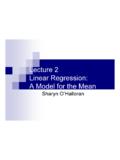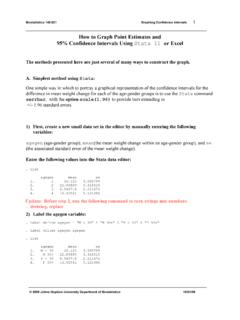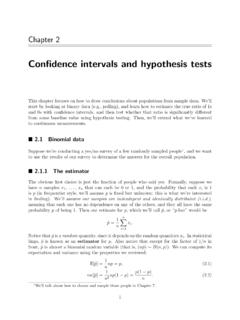Transcription of 193-29: Bootstrap 101: Obtain Robust Confidence …
1 Paper 193-29 Bootstrap 101: Obtain Robust Confidence Intervals For Any Statistic Dave P. Miller, Ovation Research Group, San Francisco, CA ABSTRACT For almost any statistic of interest, SAS/STAT PROCs generally contain options for obtaining a Confidence interval . Some PROCs even provide multiple computational methods for estimating the standard errors and Confidence intervals. In almost every case, however, the accuracy of the Confidence intervals depends on parametric assumptions. In such cases, Bootstrap methods may be used to Obtain a more Robust non-parametric estimate of the Confidence intervals. Bootstrap samples are very easy to generate using SAS software; however, it is a very computationally intensive method. In particular, the method is easy to apply in its most basic form even if you are not already familiar with Bootstrap methods, as long as you are not already stretching the capabilities of your CPU and disk space.
2 The rationale for the Bootstrap and the basics for interpreting the Confidence intervals are explained through an example. The most efficient way to program and compute Bootstrap Confidence intervals depends in part on the size of the data set and the power of one s computer. Two different approaches are suggested depending on the limitations of ones data set and computing environment. INTRODUCTION For most SAS/STAT PROCs, Confidence intervals are obtained based on a parametric estimate of the standard error ( ) for the statistic of interest ( ). Generally, the 95% Confidence interval is computed by adding or subtracting the standard error multiplied by a critical value ( ). This computation assumes that the Confidence interval is symmetric around and that the estimate of is correct. There are many situations in which the parametric assumptions may be incorrect, and it is useful in such situations to compute Bootstrap Confidence intervals that do not rely on those assumptions.
3 Distributional assumptions are commonly questioned in the presence of skewed data. Clustered data can also lead to incorrect assumptions about the error structure. Additionally, there are often statistics of interest that are a non-linear function of two or more potentially correlated statistics, and the Confidence intervals for such statistics are not readily attainable using parametric methods. When the parametric Confidence intervals are of questionable merit, or difficult to Obtain , it is possible to generate Bootstrap samples and compute the statistic of interest for each Bootstrap sample. The and percentiles of the Bootstrap samples form a good approximation of the 95% Confidence interval . This Confidence interval may be compared to the parametric Confidence interval as a sensitivity/robustness analysis, or in some cases it may be used as a substitute for the parametric Confidence interval .
4 WHAT IS A Bootstrap SAMPLE? The general class of methods known as resampling procedures includes both the jackknife and the Bootstrap . The Bootstrap is a way of using the data collected for a single experiment to simulate what the results might be if the experiment was repeated over and over with a new sample of patients. These new simulated experiments are called Bootstrap samples, and they are created by sampling with replacement from the original dataset. In a particular Bootstrap sample, a given subject from the original study may appear once, twice, many times, or not at all. This simulates what would happen if a new experiment were conducted. While the exact patient from the original study probably would not be in a new study, the number of very similar patients in the new study could be one, two, many, or none.
5 The Bootstrap was introduced and popularized by Efron (1979, 1982) and has been discussed in greater detail with many variations by other authors (Chernick, 1999). This paper focuses on the simplest form of the nonparametric Bootstrap . SUGI 29 Statistics and Data AnalysisSAMPLE DATA SET The sample data set has 200 records, one for each of 100 patients receiving treatment A (tx= A ) and 100 patients receiving treatment B (tx= B ). In addition to the treatment assignment, each record also contains a binary variable, event, indicating whether or not the patient had an event and a continuous variable, cost, that represents the total cost over the treatment period. On average, treatment A is more costly than treatment B and both distributions are heavily skewed. This is illustrated in the output from PROC MEANS below.
6 Analysis Variable : cost tx Obs Mean Minimum Maximum A 100 19108 10235 210274 B 100 11440 2046 236047 On the other hand, events are much more common for treatment B, suggesting a likely cost-effectiveness tradeoff. That is, the fact that 80% of treatment A patients were event free compared to 60% of treatment B patients implies that the cost of preventing a single event could be estimated in dollars. This is illustrated in the PROC FREQ output below. event tx Frequency Col Pct A B Total 0 80 60 140 1 20 40 60 Total 100 100 200 Specifically, based on the two sets of output above, the cost-effectiveness ratio can be computed as ($19,108-$11,440)/(80% 60%)
7 = $38,340 per event prevented. The standard error for the numerator is easy to compute; however, the fact that the costs are highly skewed may cause it to be somewhat inaccurate. More importantly, the standard error for the ratio is very messy to compute, even if strong assumptions are made about the correlation between costs and events. GENERATING Bootstrap SAMPLES In the following example, temp01 is the data set containing the variables cost, event, and tx, but this code could be used to generate 1000 Bootstrap samples for any data set. SUGI 29 Statistics and Data Analysis* Create a sequential patid, numbered 1 to N - in this case N=200; proc sort data=temp01 out=temp02; by patid; run; data temp03; set temp02; by patid; retain orig_seq_patid; if (_N_ eq 1) then orig_seq_patid=0; if then orig_seq_patid=orig_seq_patid+1; rename patid=orig_nonseq_patid; run; * Generate 1000 Bootstrap samples of random patient IDs; %let numsamp=1000; %let numpat=200; data temp04; do bootsamp=1 to do bootsamp_patid=1 to random_seq_patid=ceil(&numpat*ranuni(1)) ; output; end; end; run; * Link random patient IDs from Bootstrap samples to the original data; proc sql; create table temp05 as select distinct * from temp03 inner join temp04 on order by bootsamp, bootsamp_patid; quit.
8 Because this data set only has one record per patient, orig_seq_patid could have been assigned more easily for this particular example as orig_seq_patid=_N_, but the code that is used here could also be used without modification for a data set that had multiple records per patient. COMPUTATION OF CIs USING BY-PROCESSING The original data set had 200 records, so the new data set has 200,000 records. Because there are only a few variables involved in this analysis, a data set of this size is still manageable. Therefore, by-processing is an efficient way of programming the computation of the statistic of interest for each of the Bootstrap samples. %macro ce_ratio(indat=,outdat=,nsamps=); data _mac01; set if (1 le bootsamp le run; SUGI 29 Statistics and Data Analysis proc summary data=_mac01; where (tx eq "A"); by bootsamp; var cost event; output out=_mac02 mean=txa_avg_cost txa_event_rate; run; proc summary data=_mac01; where (tx eq "B"); by bootsamp; var cost event; output out=_mac03 mean=txb_avg_cost txb_event_rate; run; data merge _mac02 _mac03; by bootsamp; costdiff=txa_avg_cost-txb_avg_cost; events_saved=(1-txa_event_rate)- (1-txb_event_rate); if (events_saved gt 0) then ce_ratio=costdiff/events_saved; * If no events saved, set ce ratio to arbitrarily large number; else ce_ratio=100000000; run.)
9 Proc datasets lib=work; delete _mac01 _mac02 _mac03; run; %mend ce_ratio; %ce_ratio(indat=temp05, outdat=temp06, nsamps=1000); The output data set, temp06, has 1000 observations, one for each of the 1000 Bootstrap samples. Note that the code for computing the cost-effectiveness ratio for the original sample would look exactly the same as this code, but without the by bootsamp lines in each PROC and DATA step. Having computed the statistic of interest for each of the 1000 Bootstrap samples, the final step is to compute the Confidence intervals. Both the 95% CI and the 70% CI are computed using the code below. proc univariate loccount data=temp06; var ce_ratio costdiff events_saved; output out=temp07 n=n_samples pctlpre=ce_ci_ pctlpts= , ,15,85; run; proc print noobs label data=temp07; title1 " Bootstrap 95% and 70% CIs"; var n_samples ce_ci_2_5 ce_ci_97_5; var n_samples ce_ci_15 ce_ci_85; format ce_ci_2_5 ce_ci_97_5 ce_ci_15 ce_ci_85 dollar12.
10 ; run; The output from the PROC PRINT shows the two Confidence intervals, and also illustrates the high degree of uncertainty at the upper end of the range. SUGI 29 Statistics and Data AnalysisBootstrap 95% and 70% CIs number of nonmissing the the values, percentile, percentile, ce_ratio ce_ratio ce_ratio 1000 $5,420 $113,281 number of nonmissing the the values, percentile, percentile, ce_ratio ce_ratio ce_ratio 1000 $20,666 $63,745 In this example, the cost of preventing a single event may be as little as $5,000 or it may be more than $100,000. COMPUTATION OF CIs USING APPEND In the case study presented here, the statistic that was being computed did not require us to retain a large number of variables and the size of the data set was very manageable.


















